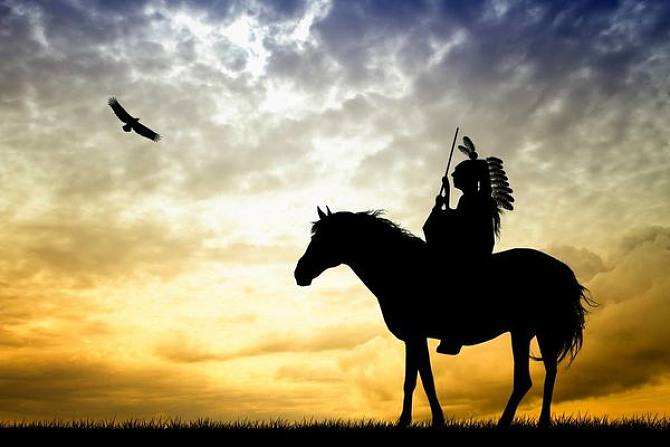The steel-trap used by the Indians is very similar to the ordinary rat-trap of England, with this difference, that it is a little larger, is destitute of teeth, and has two springs in place of one. A chain is attached to one of the springs, for the purpose of fixing a weight to the trap, so that the animal caught may not be able to drag it far from the place where it has been set. The track in the snow enables the hunter to find his trap again. It is generally so set that the jaws, when spread out flat, are exactly on a level with the snow.
印第安人使用的铁制的陷阱和常见的英格兰捕鼠夹很相似,略微不同之处在于,它的尺寸稍微大一些,没有齿,而是用两个弹簧来代替。其中一个弹簧上连着一根链子,目的是为了固定加到圈套上的重量,这样的话,被抓到的动物就不可能拖着它跑太远了。雪中的轨迹可以帮助猎人再次找到自己设的陷阱。当捕猎夹的口被打开时,正好和雪面平齐,猎人们通常就这样设置陷阱。

The chain and weight are both hid, and a thin layer of snow is spread on the top of the trap. The bait (which generally consists of chips of a frozen partridge, rabbit, or fish) is then scattered around in every direction; and, with the exception of this, nothing distinguishes the spot.
链子和砝码都要隐藏起来,只在夹子上面铺上一层薄雪。诱饵(通常是冷冻的松鸡和兔子的肉片,或者是几片鱼肉等组成)被分散的撒在不同方向上;除此之外,周围再也没有其他可辨认的东西。
Foxes, beavers, wolves, lynxes, and other animals, are caught in this way, sometimes by a fore-leg, sometimes by a hind-leg, sometimes by two legs at once, and occasionally by the nose. Of all these ways the Indians prefer catching by two legs, as there is then not the slightest possibility of the animal escaping.
狐狸、海狸、狼、山猫以及其他动物等,都是这样被捉住的,它们有时是前脚被夹住,有时是后脚被夹住,有时两条腿同时被抓住,偶尔也有被夹住鼻子的。在这些所有被抓的方式中,印第安人最喜欢的是捉住动物的两只脚了,因为这样一来落入陷阱的动物们几乎不可能逃跑了。
When foxes are caught by one leg, they often eat it off close to the trap, and escape on the other three! I have frequently seen this happen; and I once saw a fox caught which had evidently escaped in this way, as one of its legs was gone and the stump healed up and covered again with hair. When they are caught by the nose they are almost sure to escape, unless taken out of the trap very soon,as their snouts are so sharp or wedge-like that they can pull them from between the jaws of the trap without much difficulty.
当狐狸的一只脚被夹住时,它们常常会咬断被套住的那只脚,然后用其他三条腿逃走!我常常看到这种情况;有一次,我曾经看到一只被抓的狐狸显然就是用这种方式逃走的,虽然一条腿没有了,但是其伤口很快就愈合了,而且还长出了毛发。如果狐狸被夹住了鼻子,除非很快得把它们从狩猎夹中取出来,否则基本上它们肯定会逃走,因为它们的鼻子呈现尖尖的楔子型,可以不费劲的把下颚从夹子里拖出来。
Having described this machine, we shall now rejoin the Indian, whom we left on his way to his next trap. There he goes, moving swiftly over the snow, mile after mile, as if he could not feel fatigue; turning aside now and then to visit a trap, and giving a short grunt when nothing is in it; or killing the animal when caught, and tying it on the sledge.
介绍完这个设备后,我们现在要重新回到印第安人身上了,他已经走向了下一个陷阱。他动作敏捷地走在雪地上,一英里接着一英里的走了很长一段的路,似乎根本不觉得疲劳;他时不时转向这边,转向那边,到各处检查他布下的陷阱,如果夹子里什么也没有,他就会低声咕哝几声;如果有动物被捉住,他就捡起来绑在雪橇上。
Toward midnight, however, he begins to walk more cautiously, examines the priming of his gun, and moves the axe in his belt, as if he expected to meet some enemy suddenly. The fact is, that close to where he now stands are two traps which he set in the morning close to each other, for the purpose of catching one of the formidable coast wolves.
快到午夜了,然而,他开始更加小心的前行,检查了猎枪上的火药,挪动了一下腰带上的斧头,似乎预料到会发生什么突然袭击似的。事实上,就在他站的这个地方,早上他设下两个相距很近的陷阱,用以捕捉可怕的海岸狼。













